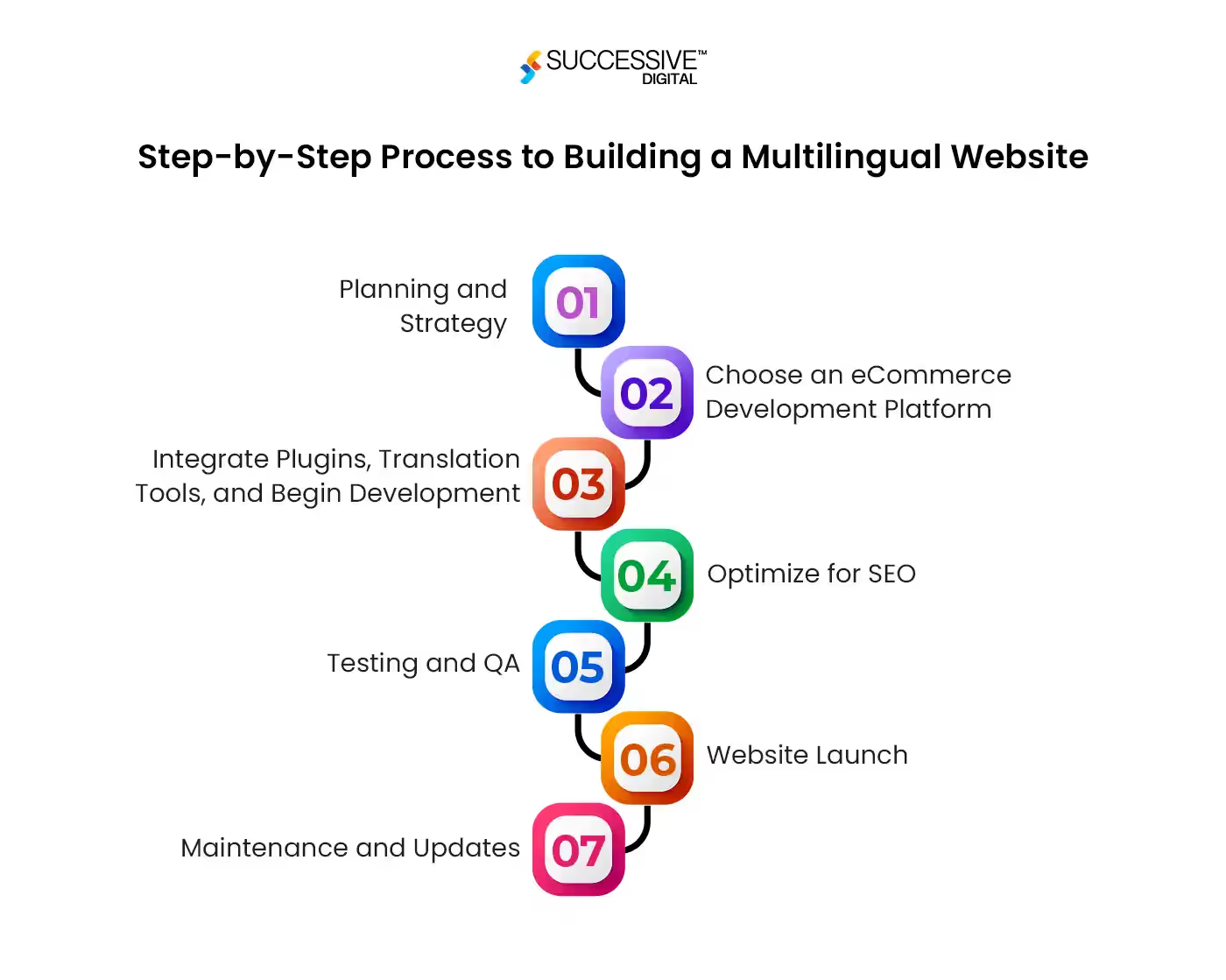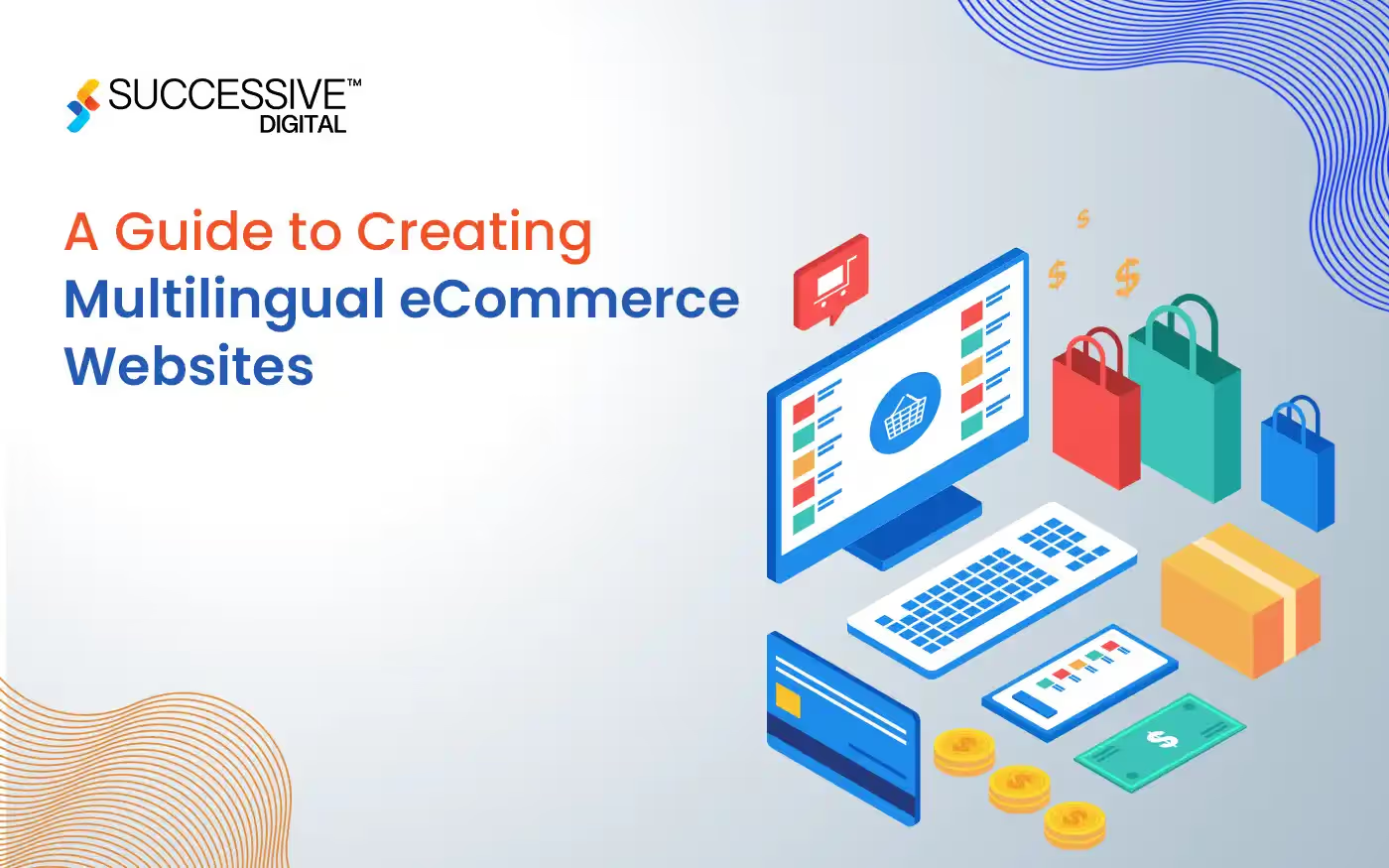The growing eCommerce industry has opened a multitude of new opportunities for businesses to grow. This also includes an opportunity to take their business global. But going international involves various procedures and incorporating personalization as global customers also expect a tailored shopping experience alike local customers. The best solution to provide a tailored experience is to create a multilingual eCommerce website. By creating such websites, businesses can expand their brand reach, customize their website as per the unique demands of global customers, and offer an enhanced customer experience. Additionally, studies show that about 73% of customers prefer to buy a product whose information is available in their mother language. This explains why multilingual websites are leading the charge over websites that support only a single language.
An Overview of Multilingual eCommerce Websites
A multilingual website is a website that allows businesses to offer their product content in multiple languages, making it accessible to a diverse audience with varying linguistic backgrounds. This type of website typically features translated versions of its pages, allowing users to switch between languages via a user-friendly interface. To understand this, take the example of Amazon. This eCommerce marketplace offers products in multiple countries and in their own languages, enabling a personalized shopping experience for its customers.If you’re looking to build a multilingual website / marketplace like Amazon, consult a professional eCommerce web development company as they can help build a customized solution for your business.
Benefits of Building a Multilingual eCommerce Website
Building a multilingual eCommerce solution comes with various benefits for businesses looking to take their business to the next level. This section will discuss them in detail:
Broader Audience Reach
With a multilingual website, you will be able to provide content in more than one language, which means you will have more customers to engage with. While 52% of website content is in English, you still have the remaining audience that falls into that 49% that prefers product information in their mother language over English. Hence, it is a great chance to bring your businesses in this remaining category and broaden your audience reach.
Increased Sales and Conversion Rates
Once you enable product content accessibility in multiple languages via your website, you automatically generate a high level of satisfaction in your customers’ minds. Imagine your customer sitting in Spain who prefers browsing content in Spanish, and suddenly, your website pops up with a product they have been looking for with a display language in Spanish. They will immediately feel connected and motivated to proceed to the checkout page. Such instances will lead to increased conversions and boosted sales for your business. Looking to created a custom-made checkout page that align with your brand image? Then deep dive into the details with our comprehensive blog on custom checkout solution.
Enhanced and Personalized Customer Experience
About 80% of customers expect a personalized shopping experience. But do you know what personalization your customers are looking for? They are looking for content from product descriptions to pricing and everything in between in their preferred language. Sometimes this can be English but for the foreign customers, the language preference is usually their native language. By fulfilling this demand, you are one step ahead to provide a tailored experience for each customer across their shopping journey in a language they are familiar with, leading to longer website engagement.
Building Trust and Loyalty with Global Customers
When you invest in building a multilingual eCommerce website and offer content in multiple linguistics, you get a chance to build trust and a stronger bond with these regional customers, which is otherwise impossible if you give them content access in a language that isn’t native to them. Once a level of trust is established, they will become loyal to your brand. And once the stage of loyalty is achieved, you can start personalized promotions such as tailored push notifications, discounts and offers, and targeted emails. This will lead to repeat purchases and continued business relations in the long run.
Localization and Cultural Sensitivity
Beyond just language, a multilingual eCommerce website often incorporates cultural nuances, idioms, and regional preferences, which further enhance the user experience and make the customers feel that you respect and acknowledge their culture and traditions. This way they will connect better with your brand and consider choosing your over your competitors.
Improved Brand Image
Businesses in the modern age need to create a strong image in the market in order to stay competitive. A website available in multiple languages is proof that you’re running a global business, which implies a degree of complexity, sophistication, and elaborateness. All of these things are highly reflected in the eyes of the customer, who will associate your business with quality and professionalism. This will boost your brand image in their eyes, leading to more sales for you, now at a global scale.
Increased Global Market Share
With the help of a multilingual website, you can positon your brand in new markets that are beyond geographical boundaries. This will help in increasing your market share on a gloabl level as now your brand is not limited to selling products in single region with a single language but the additional regions that has allowed you to expand your footprint in the global markets.
Increased Customer Engagement
Users are more likely to engage, share, and interact with content presented in their native language. Hence, with a multilingual eCommerce website, you provide your customers a comfortable platform to engage with your products in their preferred language, feel more satisfied, and, hence, quickly proceed to the payment phase.
Top Multilingual eCommerce Platforms to Choose for Website Development
Choosing the right eCommerce platform is essential to building a multilingual eCommerce website, adding customization and unique features, and making it perform well across global markets. The following two multilingual eCommerce platforms are well-known for their capabilities in helping businesses set up their international commerce operations.
- Shopify
Shopify provides a built-in eCommerce solution, known as “Shopify Markets”, to help businesses take their operations global. It allows them to create localized storefronts, calculate duties and taxes, handle cross-border complexity and region-wise compliances, as well as shipping for all locales, handled from a single store. This means businesses can simultaneously handle all their critical eCommerce operations for multiple languages and regions from a centralized dashboard. To build a website with this platform, you can hire a professional Shopify development company, discuss your requirements, and get a customized multilingual solution.
- BigCommerce
BigCommerce helps simplify international expansion for businesses as it provides built-in multi-market tools to localize website content, currencies, and channels. This allows businesses to build customized checkout experiences for each region, localize payment methods, modify storefronts, and tailor them according to each region with low code/no code capabilities. This platform also allows them to manage operations for each global region from a single dashboard panel. If you choose BigCommerce for multilingual website development, hire a trusted BigCommerce development company and get a custom-made website.
Step-by-Step Process to Building a Multilingual Website

Building a multilingual website involves several steps, from planning and design to implementation and final launch. Here are the key steps to build a multilingual website:
- Planning and Strategy
Identify the languages you want to support based on your target audience. Decide which content needs to be translated and ensure cultural relevance. Also, make a plan for multilingual SEO to ensure your website ranks well in search engines for different languages.
- Choose an eCommerce Development Platform
The next step is to choose the ideal multilingual eCommerce platform for your website development. Some of the popular ones are Shopify and BigCommerce, which provide built-in tools, plugins, and APIs to add multilingual functionality to your eCommerce website. For this, you can get assistance from a professional eCommerce development company to develop a custom-made website for your business.
- Integrate Plugins, Translation Tools, and Begin Development
Now, the website development process can be started. The development team will begin the development code and integrate translation tools, such as location-based automatic language detectors, multiple currency support, and localization APIs, to ensure that date formats, currencies, and other locale-specific elements are properly displayed. They will also integrate a CMS within the website’s backend for seamless content optimization for multiple languages from a single dashboard.
- Optimize for SEO
Optimize each language version of your website for search engines. This includes using hreflang tags, translating meta tags, and localizing keywords. Also set up analytics dashboard with the help of SEO Analytics tools to track website’s SEO performance in different languages.
- Testing and QA
Once the website development and SEO are in place, the testing phase will follow. The QA team will conduct the following tests:
- Functionality Testing - The QA team will test all website functionalities in each language to ensure everything works correctly.
- Browser and Device Testing - Ensure the website performs well across different browsers and devices, including mobile, tablets, and desktops.
Lastly, to test the content in multiple languages, it’s best to hire a translator instead of relying on tools that might be prone to errors. The translator will review the translated content thoroughly for accuracy and cultural relevance.
- Website Launch
Once the website passes the testing phase, it will be ready for the final launch. Some final checks will be made to ensure everything is in place, and then it will be launched in the market for your customers to access and start shopping for their favorite products.
- Maintenance and Updates
Like any other website, a multilingual eCommerce website also requires continuous updates and maintenance. Hence, incorporate regular updates for content in all supported languages and features, and check for errors and fix them for optimal functionality. Also, use analytics tools to monitor the performance of each language version and make adjustments as needed.
Best Practices for Creating a Multilingual Website and Achieving International Commerce Success
In often times, there are multiple challenges that arise when you develop a multilingual eCommerce website. To counter these challenges follow the best practices as shared below in this section.
- Understand Your Target Audience
Conduct market research to understand what languages your target audience speaks. Use tools like Google Analytics, social media insights, and customer feedback to gather data.Also, analyze the market demand and evaluate the potential demand for your products or services in different regions. Consider economic factors, internet penetration, and local competition.Also work on understanding the cultural preferences of your target market, such as their cultural norms, values, and traditions. This will affect the tone of your content, images, color schemes, and even website layout for each region.
- Plan Your Content Strategy
One of the important things in making a successful multilingual eCommerce website is its content and its ability to switch rapidly in every language of the region in which you will be selling your products. Hence, focus on creating high-impacting pages that drive conversions and are crucial for user engagement, such as home pages, product descriptions, service pages, and contact information. Create a content workflow to ensure a smooth flow of content for all regions. Develop a style guide that outlines the tone, voice, and writing style for each language. This helps maintain a consistent brand identity across different languages.
- Choose the Right Multilingual eCommerce Platform
This is an important element to ensure streamlined website functionality and performance in global regions. Choose an eCommerce platform that supports multiple languages and integrates smoothly with multilingual plugins or extensions. The best multilingual eCommerce platforms are BigCommerce and Shopify.
- Implement a User-Friendly Design
Incorporate the language switcher in the website’s header for easy navigation and ensure it is easily accessible to users. Design the language switcher to be intuitive, using flags or language names clearly indicating available languages. This will make it easier for users to switch to their preferred language seamlessly.Also, note that different languages can vary in length. Hence, make sure to design your multilingual eCommerce website layout in such a manner that it can accommodate text expansion or contraction without breaking the design.Furthermore, make sure the multilingual website design also adheres to cultural sensitivity. For example, make sure the product images, icons, and other visual elements are culturally appropriate and adaptable for each target market. Avoid using culturally specific images that might not resonate with any other region’s culture. The eCommerce web design
- Utilize Language Localization Tools
Lastly, make sure to utilize the best language localization tools for streamlining the multilingual operations, including:
- Auto-detection: Incorporate tools that automatically detect the user's location and display the website in the relevant language.
- Translation accuracy: While automated translations can be convenient, they aren't always accurate. Consider employing professional translation services for critical content.
- Currency and payment options: Adapt to local preferences by offering region-specific payment methods and displaying prices in local currencies.
Some of the popular language localization tools are Lokalise, Crowdin, and Transifex.
Final Word
Building a multilingual eCommerce website can be a game-changer for your business as it will allow you to run operations in the global markets. But before proceeding, you need to consider multiple things– the features, the development process, cost, best practices, and lastly, the multilingual eCommerce platform selection, as it will determine the success of your business in the long run. Successive Digital is a certified eCommerce website development company and we have a decade of experience in building solutions that yield significant outcomes. Our eCommerce team has the expertise to build a custom-made multilingual website that can fuel growth of your business.With us, you can take your business to the next level. So, Connect with our eCommerce team for strategy consultation, and let us build a custom-made multilingual eCommerce solution for your business.
.avif)



.webp)






.jpg)









